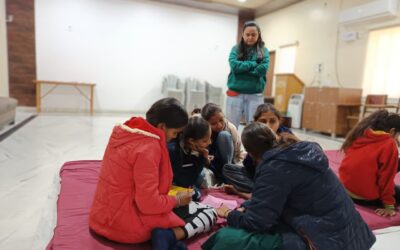“*Kishanlal is a farmer who is aspiring to make a “Pakka Makaan” which he is not able to. Money is a major constraint and he worries about his ‘Kaccha Makaan’ falling down due to the excessive rain, just like it happened with the few unfortunates who died last year.
He goes on to detail how his income from crops is so less that every year he only manages to add a few layers of bricks to his uncompleted ‘Pakka’ house. He complains about the government being no help to his family in this regard. He also talks about alcoholic people having quarrels and a lot of theft related crime that is prevalent in the area.”
This is the story of a villager who gave me shelter for a night during the ‘rural immersion’ segment of India Fellow Induction training. I, along with two co-fellows went to a village called ‘Palesar’ (it was a city in earlier times which is why it is named ‘Palesar’) which is in the ‘Kotda’ block of Udaipur district in south Rajasthan. The village is really beautiful, surrounded by greener fields with Aravalli hills and a river in background. People there spoke mix of Mewari and Hindi which was at times little difficult to understand.
I learned a lot about the village in the little time I was there. I saw that the people visible on the fields, grazing cattle, were mainly children and villagers in mid-fifties. The village was divided in three Falaan’s (hamlets) based on caste, namely: Rajput Falaan, Upla Falaan (Garesiya caste), Neechla Falaan (Gil-Garesiya caste) and came under the Gram Panchayat ‘Lambahaldu’. It had a good primary school (selected under government’s ‘Utkrisht Vidyalaya’ scheme). Also the Rajput Falaan had a good supply of electricity. The people we met were a little bit at unease on seeing us, maybe it was our ‘city’ look. But once when we interacted with them, they became quite welcoming and offered us shelter and food for the night. We heard from them issues such as the lack of fodder for their cattle, very low income levels and the disproportionate sex ratio leading to the ‘reverse dowry’ system.
Many villagers had small lands ranging from 2–15 ‘bigha’ with large families. They also migrated to nearby places on the Gujarat border and Udaipur to find work (manual labour), since the produce from farming was only sufficient to feed their own family. They had lot of animals including oxen, cows, hen, goats which are used for the purpose of milk and meat. Some villagers had complaints about corruption by the Panchayat – for example, Kishanlal ji’s money for a Swacch Bharat toilet was withheld for apparently no reason. An interesting insight that we got was that villagers did not want toilets as they were more comfortable with open defecation and deemed toilets only worthy in cases of emergency.
There was also a lack of irrigation equipment, which was one of the barriers for farmers to increase their yield of crops apart from land size and weather dependency. Many villagers felt worried about how they would divide their small land among their children for example: *Jaspal Singh from village had 5 children and 5 bigha land and was telling he does not know whether their children will make either their house or do farming. Although there was one health mission representative (from Rajput Falaan), facilities of healthcare was not accessible easily for which one had to go to Block level just to get basic healthcare facilities. Girls did go to school, but were married off at early age of 15-17 years. One villager told that there was no market for him to sale his crops and he has to go to Gujarat just to sell crops. Palesar has a lot of beautiful places to visit, for example: there was a temple around which they find brick which are claimed to have been dated way back which they say is proof of a city that existed earlier.
Thus, bit by bit, a picture of Palesar for me started forming. On the second day of immersion, I stayed in Panchayat seva kendra. My host *Shyam ji was supposed to bring ‘roti’ by 6’o clock but he got busy in something and got very late. But despite that he himself made food and brought it by 10’o clock. Hungry as I was, I was deeply satisfied by this picture I had seen, and thankful to the people who helped me form this.
*Names changed to protect identity




0 Comments